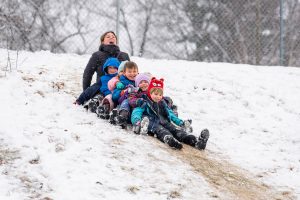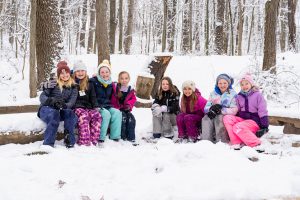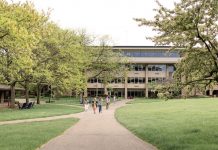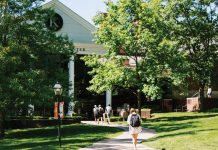
Mud. Trees. Wildlife. Milkweed. Invasive species. Building fires, studying streams, getting dirty. Week-long camp experiences, day camps and overnight trips. All these and more are part and parcel to outdoor educational experiences at schools around Grand Rapids.
School districts such as Northview Public Schools with its five-year-old Field School and Forest Hills Public Schools with Goodwillie Environmental School, which began in 1999, have created outdoor educational spaces that blend the best outdoor learning practices with traditional educational objectives. Grand Rapids Public Schools has the CA Frost Environmental Science Academy Middle and High School, which has students engaging with the outdoors at every grade level and in every subject.
Camp Roger, a nonprofit day camp and summer camp, hosts about 275 school field trips each school year on its approximately 200 acres on Belding Road, adjacent to both the old Pando ski area and Pickerel Lake properties. Roughly 11,000 students from most school districts in the greater Grand Rapids region, as well as homeschool students from across the area, take advantage of the trails, woodlands, pond, and adventure course. In addition, 2,500 kids attend a week-long summer camp each year. Camp Roger also runs Camp Scottie in Howard City, which offers day camp and summer camp programs.
“Our mission is to get kids outdoors to learn more about themselves and the people and world around them,” said Scott DeYoung, director of outdoor education. “We delight in doing that for all people and all schools.”
Camp Roger, which began back in 1913, has three components: the adventure course, with its zipline, high ropes, and climbing tower; team building activities to foster creative problem solving; and outdoor education on topics such as wetlands, invasive species, the water cycle, and animals and their habitats. The organization also hosts adults for team-building activities and retreats.
Walk through the classroom space and see tables filled with turtle and tortoise shells, animal furs, bones and skulls, a beehive, rocks, sticks and more. One winter day a group from Rockford Christian Preschool sat in a circle on the floor, bedecked in all manner of outdoor wear, tired and dirty from a morning out in the woods.
“There is a long history in writing, music and art of celebrating the beauty, mystery and wonder of the world, but over the last 25 years there is a lot of scientific research on the benefits of being outdoors,” said DeYoung. “Those who spend time outside instinctively know about these benefits, so it’s interesting to see the scientific community test those things and see them as well.”
Physical benefits include increased physical stamina, lowering blood pressure, reducing inflammation, improving sleep and strengthening the immune system. DeYoung points out a recent study that indicates better eyesight in adults who spent time outside as children.
Emotional benefits can be seen in reduced stress, anxiety, anger, improved mood and self-esteem and increased confidence.
“Educators know that anxiety and depression levels are high, so now more than ever it’s important for kids to get outdoors and use their minds and bodies in different ways,” said DeYoung.
Visit Northview’s Field School during the hour-long outside time and it’s clear these kids are delighted to be out of the inside classroom. Field School is a first-through-sixth-grade program with 140 students, with grades 1-4 held at the East Oakview and West Oakview campuses, and the 5-6 program at Highlands Middle School.

A visit to East Oakview
Several East Oakview students are checking out the milkweed plants scattered around the field. Others are exploring the small stand of trees on the edge of the property. A pair of sisters are perched in a tree. Some are just running. All are eager to talk about Field School, and every one of them has boots and snow pants caked in mud, snow, and dirt.
Matt Fenech teaches the 3-4 class at East Oakview. “We go with the flow and take advantage of learning opportunities as they arrive,” he said. “And many times, our learning has been led by their discoveries.”
One such opportunity arrived when they noticed a killdeer nest right where a new road into the school was to be created. The kids researched the killdeer, discovering it to be an endangered species. They wrote letters to the superintendent asking that the road project be reconsidered, created posters about killdeer, and were delighted when the superintendent consulted with the DNR about the tiny bird that builds its nest in gravelly areas and whose habitats are disappearing.
When it came time to build the road, the killdeer had found a new site for its nest, but that doesn’t negate what the students learned about working together to protect endangered wildlife. The vast field that is their outdoor campus is also now home to about 50 milkweed plants, the primary food source for the endangered monarch butterflies.
Students spread the milkweed seed pods hoping they would take root. Now they meticulously count the plants and keep track of the orange, black and white butterflies and their caterpillars.
A visit to CA Frost Environmental Science Middle/High School
At C.A. Frostl, Dave Kraff’s students are growing plants native to Michigan, taking them from seed to small plants, called plugs, which they plan to sell. They harvested seeds from native plants at The Highlands, a former golf course adjacent to Blandford Nature Center that is being restored to a natural landscape.
Kraff’s classroom is full of bulk flats of newly planted seeds. The goal is to grow 5,000 plugs comprised of milkweed, bee balm, black-eyed susan, gray-headed coneflower, blue vervain, common boneset, Canada goldenrod and New England aster—all native to Michigan.
He has led his environmental science students into the three acres of woods on the six-acre campus of the school located on Covell Avenue on Grand Rapids’ west side. They’ve built a trail through the woods, organized a school recycling program, investigated local lichens as bioindicators of air quality, and were instrumental in daylighting 300 feet of what they named Frost Stream, once part of an underground drainage system.
“The lens through which I view education is place-based, hands-on scientific investigation,” said Kraff, who worked as a research project manager with GVSU at the Annis Water Resources Institute before replanting himself in education. “I don’t like being indoors all day long. The more I can come up with interesting things to explore and investigate, the more we do.”
CA Frost is one of Grand Rapids Public Schools’ theme schools, which meets all the needed educational objectives while offering a wide variety of science-based electives and inserting science-based curriculum throughout the usual classes such as math, English, and social studies.
“Getting out of the building is important,” said CA Frost principal Brad Lundvick of the students who attend.

Goodwillie Environmental School
Goodwillie Environmental School principal Jason Yelding agrees. “Experiential learning is critical to not just passing tests. Rarely in real life do you have to pass a test, but you do use analysis and critical thinking skills. At Goodwillie we have the same learning standards, just taught differently in ways that seem to have students really well prepared for leadership roles and collaboration. These skills translate well into life later.”
Several sixth graders spent a recent recess candling (looking for cracks) and washing eggs gathered from the chicken coop, an outbuilding next to the main school building on 2 Mile Road east of Honey Creek Avenue. Students raise the hens from chicks, caring for them daily and traveling back to school on weekends to do so. They gather eggs, care for hurt hens, and sell the eggs, deciding this year as a group to not raise the price of their eggs despite the rise in prices at grocery stores.
“Working with the whole child is so critical,” said Yelding. “What’s unique about these teachers is that they are open to exploring new ways to engage with and inform students.”
He points to leadership skills, collaborative skills, and the ability to take another person’s perspective into consideration as benefits to the experiential, outdoor learning going on at Goodwillie, as well as creating students who have had a unique experience prior to traditional high school. “All this goes a long way toward helping them understand the world beyond themselves, which can be an ongoing challenge,” Yelding said.
Outdoor learning continues well beyond the school boundaries for all these schools. Field trips abound, occasionally even to Camp Roger. Pictured Rocks National Lakeshore, South Manitou Island, canoe trips, Sleeping Bear Dunes, and more, all designed to expand collaborative opportunities and build relationships, not to mention study different habitats and see new terrain.
“There are so many benefits to being outdoors, even in your own backyard or the park closest to your house,” said DeYoung of Camp Roger. “Being outdoors trains you to recognize the great beauty and diversity in the world. The more time children spend outdoors, the more they will love it.”
In a world in which technology and screens are ubiquitous, outdoor learning offers a counterpoint. Not that tech is ignored as students use technology in research, study and collaborative learning. As Yelding says, “We can’t live off the grid for two years, then expect the kids to be able to access a Google doc.”
But life lessons are learned outside every day and in every way. “Learning in an outdoor setting doesn’t stop on a snowy day, a rainy day, or a hot day,” Yelding said with a laugh.
Nova Conway, a 4th grader at Field School, summed it up: “We learn from our mistakes. If we forget our snow pants, we’re cold.”
A guide to outdoor learning in Grand Rapids
Schools:
CA Frost Environmental Science Middle High School—616-819-5900, 1417 Covell Ave. NW
Camp Roger—616-874-7286, 8356 Belding Rd., Rockford
Field School—616-363-6861, Northview Public Schools administration building
Goodwillie Environmental School—616-493-8633, 8400 Two Mile Rd. NE, Ada
Camps:
Camp Blodgett—616-949-0780, offices at 528 Bridge St. NW, camp in West Olive
Camp Henry—616-459-2267, 5575 S Gordon Ave, Newaygo
DeVos Family Center for Scouting and Adventure Point—616-785-2662, 3213 Walker Ave. NW, Grand Rapids
Indian Trails Camp for those with a wide variety of disabilities—616-677-5251, 0-1859 Lake Michigan Dr. NW, Grand Rapids
Little Pine Island Camp & Retreat Center—616-784-1401, 6889 Pine Island Dr. NE, Comstock Park
YMCA Camp Manitou-Lin—888-909-2267, 1095 N Briggs Rd., Middleville







Facebook Comments